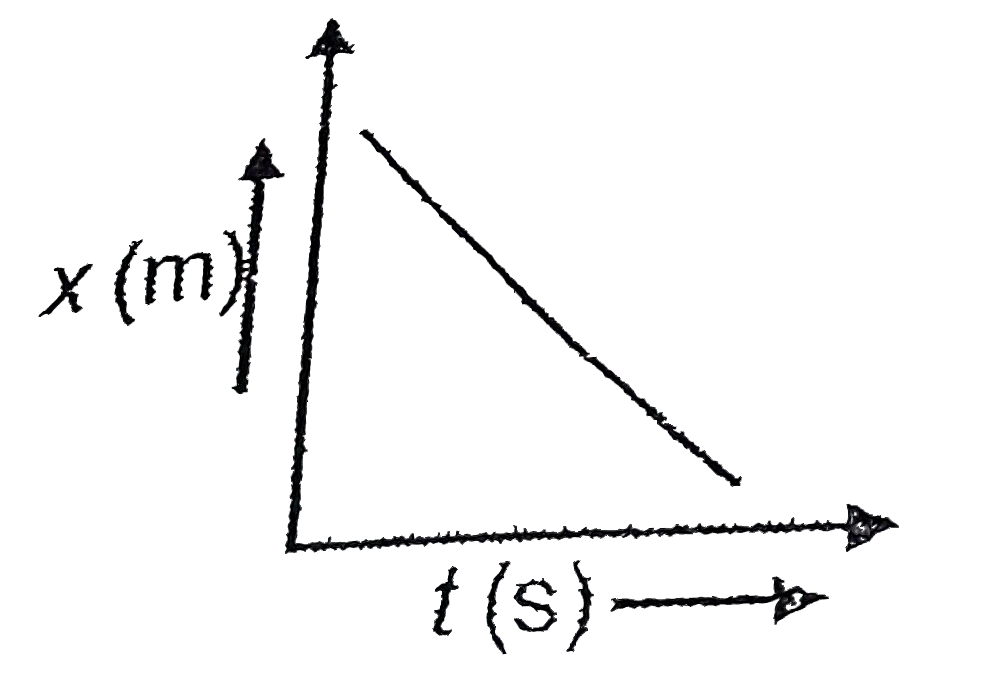An object has a uniformly acclerated motion. The object always slows down before the time, when its velcity becomes zero. Establish this statement graphiclly when (i) both initial veocity (u) and acceleration (a) are positive(iii) (u) is positive and (a) is begative and (iv) both (u) and (a) are negativ e.
When both u and a are negative : In this case, v - t graph will be as shown in figure . If we produce graph backwards, it meets the time - axis at point A . Before this time velocity is positive and decreases till it becomes zero at point A

Topper's Solved these Questions
- BOOK - MTG IIT JEE FOUNDATIONCHAPTER - FOOTSTEPS TOWARDS CBSE BOARDEXERCISE - Section - C16videos
FOOTSTEPS TOWARDS CBSE BOARD
- BOOK - MTG IIT JEE FOUNDATIONCHAPTER - FOOTSTEPS TOWARDS JEE MAIN EXERCISE - Section B (Numerical Value Type Questions)10videos
FOOTSTEPS TOWARDS JEE MAIN
- BOOK - MTG IIT JEE FOUNDATIONCHAPTER - FOOTSTEPS TOWARDS NEETEXERCISE - Multiple Choice Question45videos
FOOTSTEPS TOWARDS NEET
Similar Questions
An object has a uniformly acclerated motion. The object always slows down before the time, when its velcity becomes zero. Establish this statement graphiclly when (i) both initial veocity (u) and acceleration (a) are positive(iii) (u) is positive and (a) is begative and (iv) both (u) and (a) are negativ e.
View SolutionAn object has a uniformly acclerated motion. The object always slows down before the time, when its velcity becomes zero. Establish this statement graphiclly when (i) both initial veocity (u) and acceleration (a) are positive(iii) (u) is positive and (a) is begative and (iv) both (u) and (a) are negativ e.
View Solution
Knowledge Check
- Question 1 - Select One
An object is moving with uniform acceleration a. Its initial velocity is u and after time t its velocity is v. The equation of its motion is v = u + at. The velocity (along y-axis) time (along x-axis) graph shall be a straight line
Apassing through originBwith x-intercept uCwith y-intercept uDwith slope u - Question 2 - Select One
Statement 1 : An object thrown vertically up with a velocity u reaches the maximum height h after T seconds. At a time 2T seconds its velocity becomes zero.
Statement 2: An object thrown vertically up with a velocity comes back to its initial position with same magnitude of velocity but in opposite direction.ABoth statements 1 and 2 are true and statement 2 is the correct explanation of statement 1.BBoth statements 1 and 2 are true but statement 2 is not the correct explanation of statement 1.CStatement 1 is true but statement 2 is false.DStatement 1 is false but statement 2 is true.
An object has uniformly accelerated motion . The object always slows down before the time, when its velocity becomes zero. Prove this statement graphically, when
u is positive and a negative andView SolutionAn object has uniformly accelerated motion . The object always slows down before the time, when its velocity becomes zero. Prove this statement graphically, when
u is negative and a is positiveView SolutionRepresent the motion of an object in unifrom motion along a straight line when both initial distance and velocity of the object is positive .
View SolutionA particle is moving along x-direction with a constant acceleration a. The particle starts from x=x0 position with initial velocity u. We can define the position of the particle with time by the relation
x=x0+ut+12at2
plot the position of the particle in relation with time is following situations
(i) If initial position of the particle is on negativ x-axis, initial velocity is positive and acceleration is negative.
(ii) If initial position is positive, initial velocity is negative and acceleration is positive.View SolutionThe position-time (x-t) graph of an object in uniform motion is shown below, the velocity of object is
(i) Positive
(ii) Negative
(iii) Zero
(iv) None of these
 View Solution
View Solution

For a particle moving along straight line with constant acceleration (a), we define velocity of the particle with time as
v=u+at, (u=initial velocity)
Draw the velocity-time graph of the particle in following situations.
(i) Velocity is decresing with time (i.e., acceleration in negative)
(ii) Initial velocity is negative but acceleration is positiveView Solution

